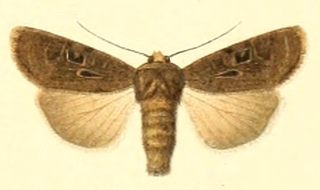
The Noctuidae, commonly known as owlet moths, cutworms or armyworms, are a family of moths. They are considered the most controversial family in the superfamily Noctuoidea because many of the clades are constantly changing, along with the other families of the Noctuoidea. It was considered the largest family in Lepidoptera for a long time, but after regrouping Lymantriinae, Catocalinae and Calpinae within the family Erebidae, the latter holds this title now. Currently, Noctuidae is the second largest family in Noctuoidea, with about 1,089 genera and 11,772 species. This classification is still contingent, as more changes continue to appear between Noctuidae and Erebidae.

Panthea coenobita is a species of moth of the family Noctuidae. It is found in North Europe, East Europe and Southern Europe, the central and northern European part of Russia, Japan, Korea, northern China, the Russian Far East, southern and western Siberia and Turkey.
Eogena is a monotypic moth genus of the family Noctuidae erected by Achille Guenée in 1852. Its only species, Eogena contaminei, was first described by Eduard Friedrich Eversmann in 1847. It is found in southern Russia, Turkey, Transcaucasia and Central Asia.
Plecoptera inquinata is a species of moth of the family Noctuidae first described by Julius Lederer in 1857. It is found in Turkey, Azerbaijan, Iran, Lebanon and Israel.
Exophyla rectangularis is a moth of the family Noctuidae first described by Carl Geyer in 1828. It is found in Ukraine, Romania, Bulgaria, Albania, Greece, Montenegro, Croatia, northern Italy, Mediterranean Turkey, Lebanon, Israel and Turkmenistan.
Autophila anaphanes is a moth of the family Erebidae first described by Charles Boursin in 1940. It is found in the eastern part of the Mediterranean, including the Balkans, Cyprus, Turkey, Lebanon and Israel.

Lygephila lusoria is a moth of the family Erebidae. The species was first described by Carl Linnaeus in his 1758 10th edition of Systema Naturae. It is found in southern Europe, the Near East and Middle East, European south-eastern Russia, the Caucasus, Turkey and Israel.
Armada panaceorum is a moth of the family Noctuidae first described by Édouard Ménétries in 1848. It is found in the arid parts of North Africa, the Near East and the Middle East, Kazakhstan, eastern Afghanistan, Mongolia, Tibet and south-eastern Turkey.

Catocala separata is a moth of the family Erebidae first described by Christian Friedrich Freyer in 1846. It is found in the Balkans, the Mediterranean part of southern Turkey and the Levant.
Clytie syriaca is a moth of the family Erebidae first described by Charles-Juste Bugnion in 1837. It is found along the coastal regions of the Mediterranean Basin, from the Balkans to Turkey, Lebanon, Syria and Israel.
Pericyma albidentaria is a moth of the family Erebidae first described by Christian Friedrich Freyer in 1842. It is found in south-eastern Europe, the Near East, the Middle East, Afghanistan, Iran, Iraq, Syria, Turkey, Cyprus and Israel.
Pericyma squalens is a moth of the family Noctuidae first described by Julius Lederer in 1855. It is found in south-eastern Turkey, Iran, Iraq, Afghanistan, Turkmenistan, Kuwait, Saudi Arabia, Egypt, Lebanon, Israel and Jordan.

Chazaria incarnata is a species of moth of the family Noctuidae. It is found on the Canary Islands and on the Iberian Peninsula, east to Italy, Serbia, Romania, Bulgaria, North Macedonia and Greece. Further east it is found to southern and eastern Russia in the north and Turkey, the Dead Sea region of Israel and Iran.
Schinia imperialis is a moth of the family Noctuidae. It is found in Daghestan and Turkey.

Chersotis andereggii is a moth of the family Noctuidae.
The Micronoctuini are a tribe of moths in the family Erebidae that includes about 400 described species. Typical species in the tribe have bifine hindwing venation and are smaller than those in other noctuoid moths. Micronoctua karsholti is the smallest of all species in the superfamily Noctuoidea.

Oxicesta geographica is a moth of the family Noctuidae. It is found in southern Romania, Austria, Hungary, from the former Yugoslavia to northern Greece and Turkey. It has also been reported from Russian Moldavia and Georgia.

Scirpophaga praelata is a species of moth of the family Crambidae. It is found in most of Europe, Russia, Turkey, Iran, Syria, Lebanon, North Africa, Japan, Taiwan, China and Australia.
Caradrina vicina is a moth of the family Noctuidae. It was described by Staudinger in 1870. It is found from Central and Southeastern Europe, eastern and central Anatolia, and Western to Central Asia. The habitat consists of grasslands.

Chersotis rectangula is a moth of the family Noctuidae. It is the type species of the genus Chersotis.









